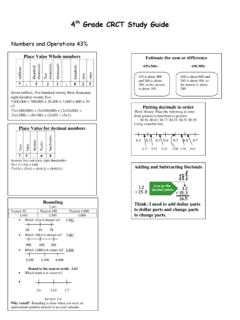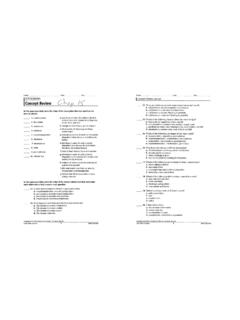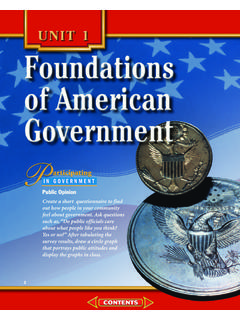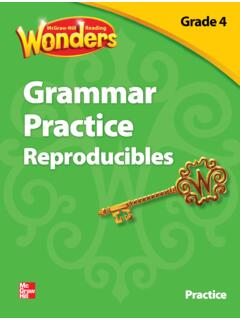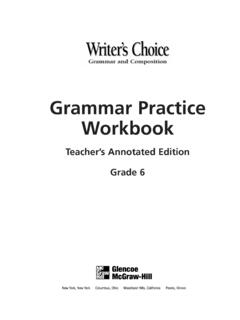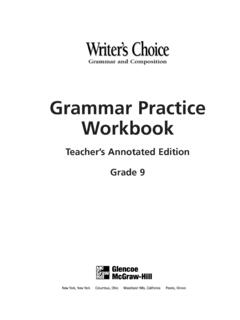Transcription of Grammar and Language Workbook - Henry County Schools
1 GLENCOELANGUAGEARTSG rammar and LanguageWorkbookGRADE10 Copyright by The McGraw-Hill Companies, Inc. All rights reserved. Except as permitted under the United StatesCopyright Act of 1976, no part of this publication may be reproduced or distributed in any form or means, or stored ina database or retrieval system, without the prior written permission of the all inquiries to:Glencoe/McGraw-Hill936 Eastwind DriveWesterville, Ohio 43081 ISBN 0-02-818296-0 Printed in the United States of America1 2 3 4 5 6 7 8 9 10 024 03 02 01 00 99 Glencoe/McGraw-HillTable of ContentsiiiCopyright by Glencoe/McGraw-HillHandbook of Definitions and Rules ..1 Troubleshooter ..21 Part 1 Grammar ..45 Unit 1 Parts of : Concrete, Abstract, and Collective : Proper and Common .. : Personal and Possessive;Reflexive and : Interrogative and Relative;Demonstrative and Indefinite.
2 Verbs: Transitive and Intransitive .. Verbs .. Phrases .. : Coordinating, Correlative,and Adverbs and Interjections ..71 Unit 1 Review ..73 Cumulative Review: Unit 1 ..74 Unit 2 Parts of the Subjects and Simple Predicates .. Subjects and Complete Predicates .. Subjects and CompoundPredicates .. of Subject and : Direct and Indirect Objects .. Complements and 2 Review ..87 Cumulative Review: Units 1 3 Phrases .. and Appositive and Participial Phrases .. and Gerund Phrases .. and Infinitive Phrases ..97 Unit 3 Review ..99 Cumulative Review: Units 1 4 Clauses and Sentence and Subordinate Clauses .. and Compound Sentences .. and Compound-Complex Clauses .. of Fragments .. 4 Review ..125 Cumulative Review: Units 1 5 Diagraming Simple Sentences.
3 Simple Sentences with Sentences with 5 Review ..137 Cumulative Review: Units 1 6 Verb Tenses and Verbs .. Tenses: Present, Past, and Future .. Tenses: Present, Past, and Future Tenses .. and Emphatic Forms .. of Tenses .. of Verbs: Active and Passive ..155 Unit 6 Review ..157 Cumulative Review: Units 1 7 Subject-Verb Agreement .. : Intervening : Linking Verbs .. : Inverted Sentences .. : Special Subjects .. : Compound Subjects .. : Intervening : Indefinite Pronouns as 7 Review ..177 Cumulative Review: Units 1 8 Using Pronouns Pronouns: with and as Appositives; AfterThan and and Whom in Questions andSubordinate Agreement:Number and Agreement:Person .. Agreement:Indefinite Pronoun Antecedents .. Pronoun Reference ..193 Unit 8 Review ..195 Cumulative Review: Units 1 by Glencoe/McGraw-HillUnit 9 Using Modifiers : Three Degrees of Comparison.
4 : Irregular : Double and Good and Well; Bad and and Dangling Modifiers ..209 Unit 9 Review ..213 Cumulative Review: Units 1 2 Usage ..217 Unit 10 Usage Usage: a to Usage: amount to could Usage: different fromto Usage: this kindto reason is Usage: respectfully to where 10 Review ..229 Cumulative Review: Units 1 10 ..230 Part 3 Mechanics ..233 Unit 11 Capitalization of Sentences .. Capitalization of Proper Nouns .. Capitalization of Proper 11 Review ..241 Cumulative Review: Units 1 11 ..242 Unit 12 Punctuation, Abbreviations, and End-of-Sentence Punctuation .. Colons .. Semicolons .. Commas: Compound Sentences .. Commas: Series and Coordinate Adjectives .. Commas: Nonessential Commas: Interjections, ParentheticalExpressions, and Conjunctive Commas: Introductory Phrases, AdverbClauses, and Antithetical Phrases.
5 Commas: Titles, Addresses, and Numbers .. Commas: Direct Address, Tag Questions, and Letters .. Commas in Dashes to Signal Change and to Emphasize .. Quotation Marks for Direct Quotations .. Quotation Marks with Titles of Short Works, Unusual Expressions, and with Other Marks of Punctuation .. Italics (Underlining) .. The The Abbreviations .. Numbers and Numerals ..283 Unit 12 Review ..285 Cumulative Review: Units 1 12 ..286 Part 4 Vocabulary & 13 Vocabulary and Building Vocabulary: Learning from Building Vocabulary: Word Building Vocabulary: Prefixes and Suffixes .. Basic Spelling Rules I .. Basic Spelling Rules II ..299 Review: Building Vocabulary ..301 Review: Basic Spelling Rules ..303 Part 5 Composition ..305 Unit 14 The Writing Process: Prewriting.
6 The Writing Process: Drafting .. The Writing Process: Revising .. The Writing Process: Editing .. The Writing Process: Presenting .. Outlining .. Writing Effective Sentences .. Building Paragraphs .. Paragraph Ordering .. Personal Letters .. Business Letters: Letters of Request orComplaint .. Business Letters: R sum s and Cover Letters ..339 Index ..343 TAE TestsUnit 1: Parts of Speech ..349 Unit 2: Parts of the Sentence ..353 Unit 3: Phrases ..355 Unit 4: Clauses and Sentence Structure ..359 Unit 5: Diagraming Sentences ..361 Unit 6: Verb Tenses and Voice ..363 Unit 7: Subject-Verb 8: Using Pronouns Correctly ..369 Unit 9: Using Modifiers 10: Usage ..373 Unit 11: Capitalization ..375 Unit 12: Punctuation, Abbreviations, and Numbers ..377 Unit 13: Vocabulary and 14: Composition.
7 383 Answer Key ..387iv Glencoe Grammar and Language Workbook , Grade 10 Handbook1 Handbook ofDefinitionsand RulesCopyright by Glencoe/McGraw-HillHandbook2 Glencoe Grammar and Language Workbook , Grade 10 PARTS OF singular nounis a word that names one person, place, thing, or idea: brother, classroom ,piglet, and joy. A plural nounnames more than one person, place, thing, or idea: brothers,classrooms, piglets, and help you determine whether a word in a sentence is a noun, try adding it to the followingsentences. Nouns will fit in at least one of these sentences:I know something about know something about a(n) know something about know something about a collective nounnames a group. When the collective noun refers to the group as a whole, it issingular. When it refers to the individual group members, the collective noun is class meets two days a week.
8 (singular)The board of trustees come from all walks of life. (plural) common nounnames a general class of people, places, things, or ideas: soldier, country,month, or theory. A proper nounspecifies a particular person, place, thing, event, or nouns are always capitalized: General Schwartzkopf, America, July, or Big concrete nounnames an object that occupies space or that can be recognized by any of thesenses: tuba, music, potato, and aroma. An abstract nounnames an idea, a quality, or acharacteristic: courage, sanity, power, and possessive nounshows possession, ownership, or the relationship between two nouns:Raul s house, the cat s fur, and the girls soccer pronoun takes the place of a noun, a group of words acting as a noun, or another personal pronounrefers to a specific person or thing.
9 First personpersonal pronouns referto the speaker, second personpronouns refer to the one spoken to, and third personpronounsrefer to the one spoken CasePossessive CaseObjective CaseFirst Person, SingularImy, minemeFirst Person, Pluralweour, oursusSecond Person, Singularyouyour, yoursyouSecond Person, Pluralyouyour, yoursyouThird Person, Singularhe, she, ithis, her, hers, itshim, her, itThird Person, Pluraltheytheir, reflexive pronounrefers to the subject of the sentence. An intensive pronounadds emphasisto a noun or another pronoun. A demonstrative pronounpoints out specific persons, places,things, or :They psyched themselves up for the football :Freddie himself asked Julie :That is a good idea!Those are my interrogative pronounis used to form questions. A relative pronounis used to introduce asubordinate clause.
10 An indefinite pronounrefers to persons, places, or things in a more generalway than a noun :Which is your choice?With whom were you playing video games?Handbook3 Copyright by Glencoe/McGraw-HillHandbookRelative:The cake thatwe baked was :Everyone has already oneshould enter without antecedent of a pronoun is the word or group of words referred to by the rode his bike to school . (Benis the antecedent of his.) verb is a word that expresses action or a state of being and is necessary to make a verbs will fit one or more of these sentences:We _____ _____ _____ .We remain love it!It action verbtells what someone or something does. The two types of action verbs aretransitive and intransitive. A transitive verbis followed by a word or words that answer thequestion what?

